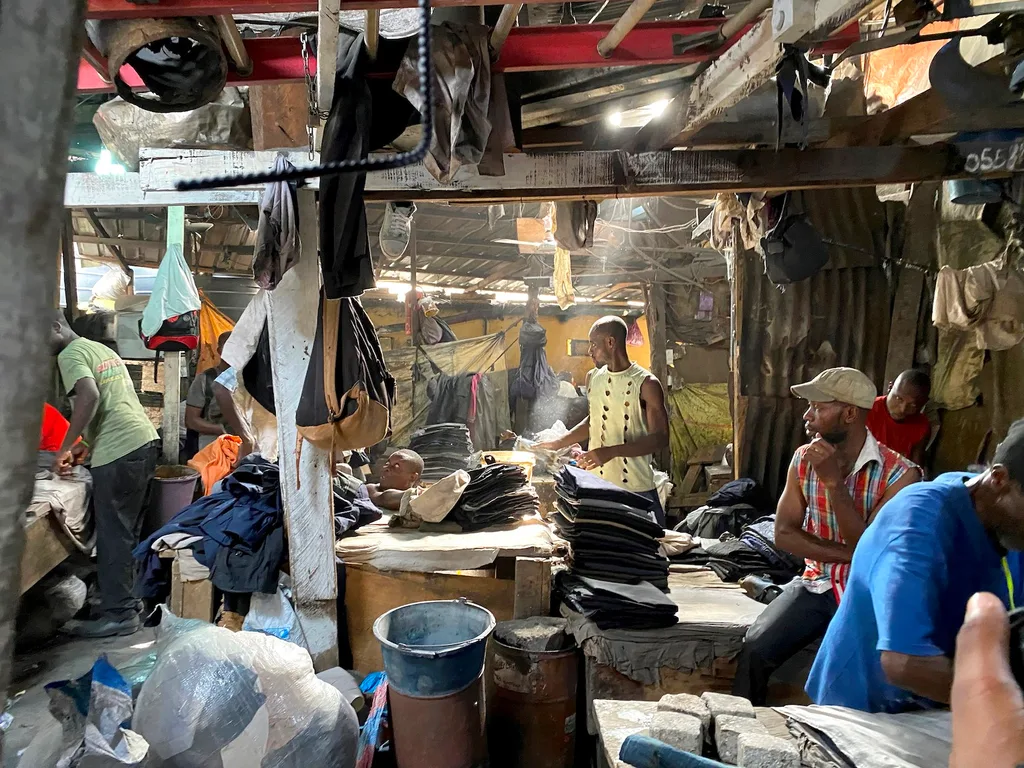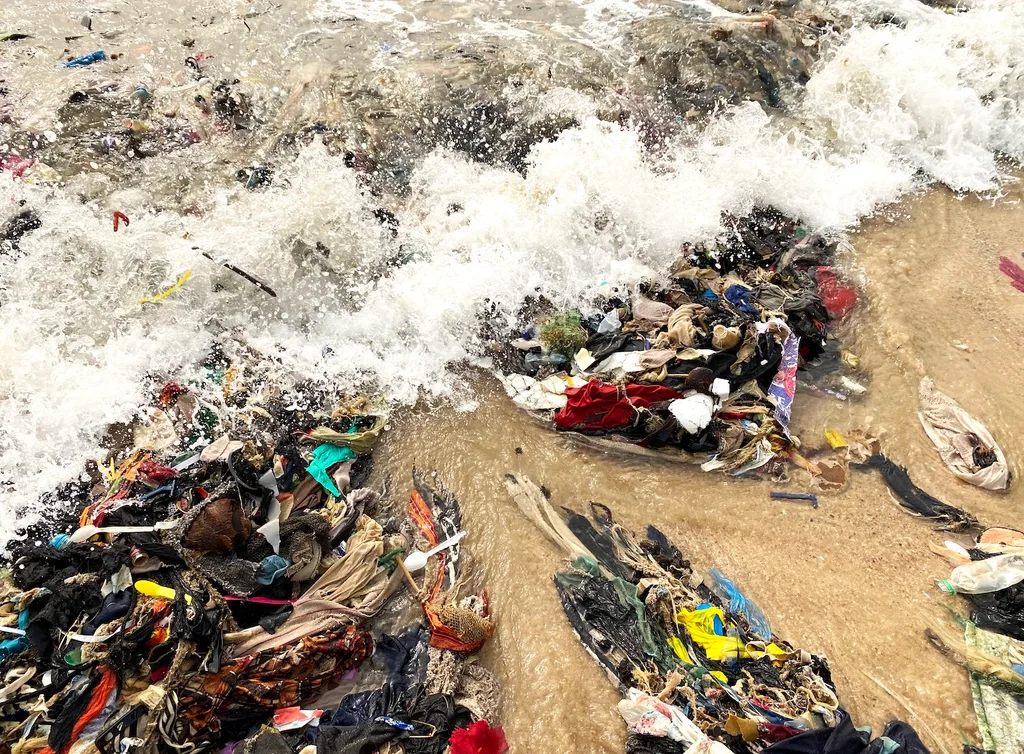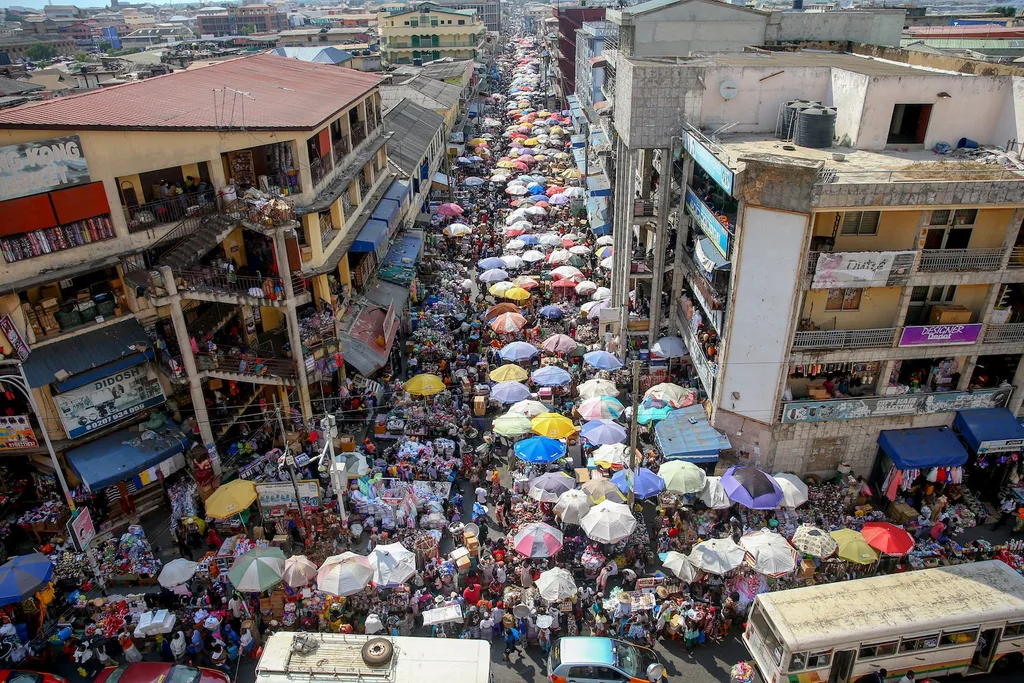Monsters are real. They’re just made of polyester. Fishermen off Osu Beach in Accra, Ghana, know to look out for these man-made creatures from the deep that can tangle in their boat propellers.
“We call them ‘tentacles,’” explains Liz Ricketts, co-founder of The Or Foundation, an Accra-based non-profit focused on the second-hand clothing sector. Unwanted garments, she explains, wend their way from the city’s huge second-hand clothing market, Kantamanto, to the sea, where they clog into lumpy ropes that don’t biodegrade.
Last year, a report by the UK-based Changing Markets Foundation, Synthetics Anonymous: Fashion Brands’ Addiction to Fossil Fuels, revealed how our clothes are mostly made from plastic. Synthetic fibres now represent more than two-thirds of all materials used in textiles. And it’s getting worse – that number is expected to reach nearly three- quarters by 2030.

Footage from The Or Foundation shows plastic litter lapping the sand on Osu Beach, and mixed in with the bottles, packaging and takeaway forks are clothes. While it’s hard to pick out a shirt from a skirt in the tangle of waste, you can see their colours and prints.
“Some are dumped directly on the beach, although most go through the open sewers, swept from the markets, pushed out by the rain. They may have soaked up industrial and human excrement on their way here.”
In 2021, Accra’s main official landfill, Kpone, was closed after it repeatedly caught fire, and the city’s textile waste situation has since worsened. In the Old Fadama slum, says Ricketts, waste “mountains” reach 10 metres high – more than half of it textiles. Back on the beach, “The daunting thing is what we can’t see,” says Ricketts, “because the ‘tentacles’ come up and go back with the tide, so the only thing to assume is that there’s more on the sea floor or buried in the sand.”
While the trash hills grow, waiting for a solution that never comes, garbage inevitably escapes into the broader environment. This is a horror story, but it’s also a whodunit. How do these garments end up here? And who is responsible?

Kantamanto is one of the largest second-hand clothing markets in the world. The stock arrives from overseas, but it’s not all preloved. An increasing proportion is dead stock sold on by brands in the Global North. The fashion industry routinely and deliberately overproduces because it cannot predict demand, hence The Or Foundation describes Kantamanto as “the world’s largest consolidated resale platform, recirculating hundreds of millions of items annually”.
More than 30,000 people work here – from import and resale, upcycling, making, mending and ironing, to food service and music. It’s a place of ingenuity, creativity, resourcefulness and entrepreneurship. It generates employment, community, style and opportunity. Ricketts says it’s her “favourite place on the planet”. But it’s also paying the price of our unsustainable global fashion system, one built on waste and exploitation, where the most vulnerable further down the supply chain bear the brunt of negative impacts.

In the market, the kayayei, or female porters, carry bales of clothing on their heads from importers to retailers, from retailers to storage, from retailers to consumers, and everywhere in between. These bales weigh between 50 and 90 kilograms. Some of the porters are as young as eight, although most are between 16 and 25. It’s dangerous work, and in some cases has proved fatal.
At one of the market’s entrances, there’s a sign that reads ‘Obroni wawu: dead white man’s clothes’. The term dates from when Ghana began importing used clothing in the 1960s, and it was prized for its quality and quality. The 2020 documentary Textile Mountain shows discarded shoes and clothes piling up in the city’s Dandora dump. Filmmakers Fellipe Lopes and Caitriona Rogerson report that “140,000 tonnes of used clothing are imported into Kenya via Mombasa each year, mainly from Europe, the US and Canada.” Kenyan mitumba retailers told them up to half of each bale “is of such poor quality it cannot be resold” and gets burnt or landfilled.

Omer Soker says: “If donated items are torn, damaged or stained, they will mostly go straight to landfill in Australia. Some, about 100,000 tonnes, does get turned to rags, but these textiles have to be made from an absorbent material like cotton – think old cotton trackie daks.” He’s not falling over himself to promote that, though. “People hear it mentioned and think, ‘Oh great I can give all my ruined stuff to charity because they can turn it into rags.’ No, we can’t, because most of it is unsuitable mixed fibres.”
Bottom line: charities don’t benefit from your unfit-for-rewear Lycra leggings. That said, Soker wants to emphasise that “Charities are grateful for your donations.”
The best items (16.5 per cent) are sold in Australian op shops. Another 14 per cent is landfilled here, 36 per cent is recycled domestically, a small faction is donated directly to people in need here, and the remaining third is exported.










